maintenance CITROEN C-ELYSÉE 2018 Handbook (in English)
[x] Cancel search | Manufacturer: CITROEN, Model Year: 2018, Model line: C-ELYSÉE, Model: CITROEN C-ELYSÉE 2018Pages: 260, PDF Size: 8.4 MB
Page 3 of 260
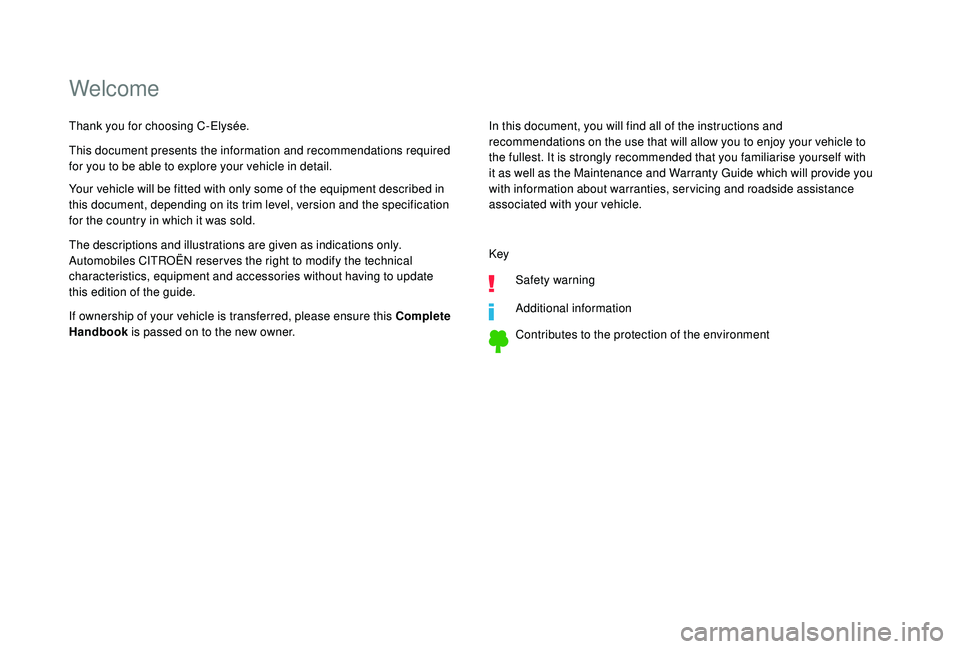
Welcome
In this document, you will find all of the instructions and
recommendations on the use that will allow you to enjoy your vehicle to
the fullest. It is strongly recommended that you familiarise yourself with
it as well as the Maintenance and Warranty Guide which will provide you
with information about warranties, servicing and roadside assistance
associated with your vehicle.
Thank you for choosing C-Elysée.
This document presents the information and recommendations required
for you to be able to explore your vehicle in detail.
Your vehicle will be fitted with only some of the equipment described in
this document, depending on its trim level, version and the specification
for the country in which it was sold.
The descriptions and illustrations are given as indications only.
Automobiles CITROËN reser ves the right to modify the technical
characteristics, equipment and accessories without having to update
this edition of the guide.
If ownership of your vehicle is transferred, please ensure this Complete
Handbook
is passed on to the new owner. Key
Safety warning
Additional information
Contributes to the protection of the environment
Page 5 of 260
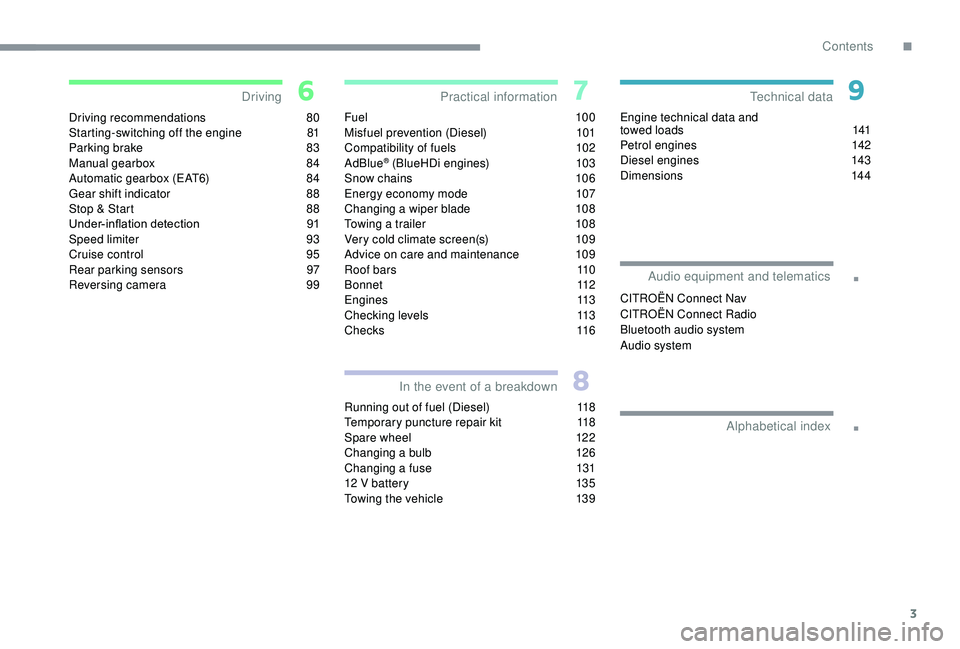
3
.
.
Driving recommendations 80
Starting-switching off the engine 8 1
Parking brake
8
3
Manual gearbox
8
4
Automatic gearbox (EAT6)
8
4
Gear shift indicator
8
8
Stop & Start
8
8
Under-inflation detection
9
1
Speed limiter
9
3
Cruise control
9
5
Rear parking sensors
9
7
Reversing camera
9
9Fuel 1
0 0
Misfuel prevention (Diesel) 1 01
Compatibility of fuels
1
02
AdBlue
® (BlueHDi engines) 1 03
Snow chains 1 06
Energy economy mode
1
07
Changing a wiper blade
1
08
Towing a trailer
1
08
Very cold climate screen(s)
1
09
Advice on care and maintenance
1
09
Roof bars
1
10
B o n n e t
112
Engines
1
13
Checking levels
1
13
C h e c k s
11
6
Running out of fuel (Diesel)
1
18
Temporary puncture repair kit
1
18
Spare wheel
1
22
Changing a bulb
1
26
Changing a fuse
1
31
12
V battery
1
35
Towing the vehicle
1
39Engine technical data and
towed loads
1
41
Petrol engines
1
42
Diesel engines 1 43
Dimensions 144
DrivingPractical information
In the event of a breakdown Technical data
Alphabetical index
Audio equipment and telematics
CITROËN Connect Nav
CITROËN Connect Radio
Bluetooth audio system
Audio system
.
Contents
Page 9 of 260
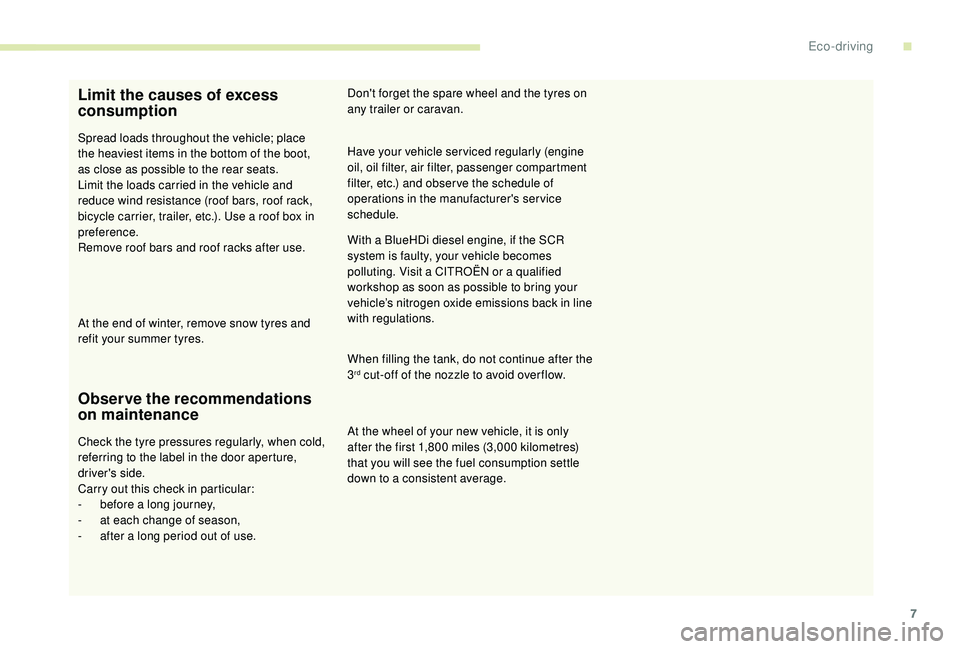
7
Limit the causes of excess
consumption
Spread loads throughout the vehicle; place
the heaviest items in the bottom of the boot,
as close as possible to the rear seats.
Limit the loads carried in the vehicle and
reduce wind resistance (roof bars, roof rack,
bicycle carrier, trailer, etc.). Use a roof box in
preference.
Remove roof bars and roof racks after use.
At the end of winter, remove snow tyres and
refit your summer tyres.
Observe the recommendations
on maintenance
Check the tyre pressures regularly, when cold,
referring to the label in the door aperture,
driver's side.
Carry out this check in particular:
-
b
efore a long journey,
-
a
t each change of season,
-
a
fter a long period out of use. Have your vehicle ser viced regularly (engine
oil, oil filter, air filter, passenger compartment
filter, etc.) and obser ve the schedule of
operations in the manufacturer's service
schedule. Don't forget the spare wheel and the tyres on
any trailer or caravan.
With a BlueHDi diesel engine, if the SCR
system is faulty, your vehicle becomes
polluting. Visit a CITROËN or a qualified
workshop as soon as possible to bring your
vehicle’s nitrogen oxide emissions back in line
with regulations.
When filling the tank, do not continue after the
3
rd cut-off of the nozzle to avoid over flow.
At the wheel of your new vehicle, it is only
after the first 1,800
miles (3,000 kilometres)
that you will see the fuel consumption settle
down to a consistent average.
.
Eco-driving
Page 49 of 260

47
Turn off the defrosting of the rear
screen and side mirrors (depending on
the version) as soon as you consider it
necessary.
Because lower energy consumption
reduces fuel consumption.Advice
In order for these systems to be fully
effective, follow the operation and
maintenance guidelines below:
F
T
o ensure that the air is distributed
evenly, keep the external air intake
grilles at the base of the windscreen, the
nozzles, the vents, the air outlets and the
air extractor located in the back free from
obstructions.
F
O
perate the air conditioning system for
at least 5
to 10 minutes, once or twice a
month to keep it in per fect working order.
F
T
o prevent misting or deteriorating
air quality inside the passenger
compartment, you should not deactivate
the system for too long and avoid
extended operation of the air recirculation
system when driving.
F
E
nsure that the passenger compartment
filter is in good condition and have the
filter elements replaced regularly.
We recommend the use of a combined
passenger compartment filter. Thanks to
its special active additive, it contributes
to the purification of the air breathed by
the occupants and the cleanliness of the
passenger compartment (reduction of
allergic symptoms, bad odours and greasy
deposits). F
T o ensure correct operation of the air
conditioning system, you are also advised
to have it checked regularly according
to the Maintenance and Warranty Guide
recommendations.
F
I
f the system does not produce cold air,
switch it off and contact a CITROËN
dealer or a qualified workshop.
When towing the maximum load on a steep
gradient in high temperatures, switching off
the air conditioning increases the available
engine power and so improves the towing
ability.
3
Ease of use and comfort
Page 57 of 260

55
Windscreen wash
Pull the wiper control stalk towards you. The
windscreen washer and then the wipers
operate for a fixed time.The screenwash jets are not adjustable.
Do not try to move them (risk of damage).
Special position of the
windscreen wipers
This maintenance position is used for cleaning
or replacement of the wiper blades. It can also
be useful, in winter, to release the wiper blades
from the windscreen.
F
O
perate the wiper stalk within one minute
after switching off the ignition to position the
wiper blades vertically on the windscreen. F
T
o park the wiper blades again, switch on
the ignition and operate the wiper stalk.
To maintain the effectiveness of the flat
wiper blades, it is advisable to:
-
h
andle them with care,
-
c
lean them regularly using soapy
water,
-
a
void using them to retain cardboard
on the windscreen,
-
r
eplace them at the first signs of wear.
Courtesy lamps
A
Courtesy lamps
B Map reading lamps
4
Lighting and visibility
Page 87 of 260

85
Displays in the instrument panelFoot on the brake pedal
F Press the brake pedal when this warning lamp is displayed in the
instrument panel (e.g. starting
the engine).
Moving off
Automatic operation
F Select position D for automatic changing of
the six gears.
The gearbox then operates in auto-adaptive
mode, without any action needed from the
driver. It continuously selects the most suitable
gear according to the style of driving, the profile
of the road and the load in the vehicle.
F
A
pply the parking brake.
F
Sel
ect position P or N
.
F
S
tart the engine.
If these conditions are not met, you will hear an
audible signal, associated with the display of a
warning message.
F
W
ith the engine running, press the brake
pedal.
F
R
elease the parking brake.
F
Sel
ect position R
, D or M.
F
G
radually release the brake pedal.
The vehicle moves off immediately.
If position N is selected inadvertently while
driving, allow the engine to return to idle
then select position D before accelerating. If the exterior temperature is below -23°C,
the engine should be left at idle for four
minutes, to ensure the correct operation
and life of the engine and gearbox.
When the engine is running at idle with the
brakes released, if position R
, D or M is
selected, the vehicle moves even without
the accelerator being pressed.
Never leave children unsuper vised in the
vehicle when the engine is running.
When carrying out maintenance with the
engine running, apply the parking brake
and select position P .
When you move the selector to select a
position, the corresponding indicator is
displayed in the instrument panel.
P.
Park.
R. Reverse.
N. Neutral.
D. Drive.
S. Sport programme.
T . Snow
programme.
1
2
3
4
5
6.
Gears engaged during manual
operation.
-. Invalid value during manual
operation.
6
Driving
Page 110 of 260
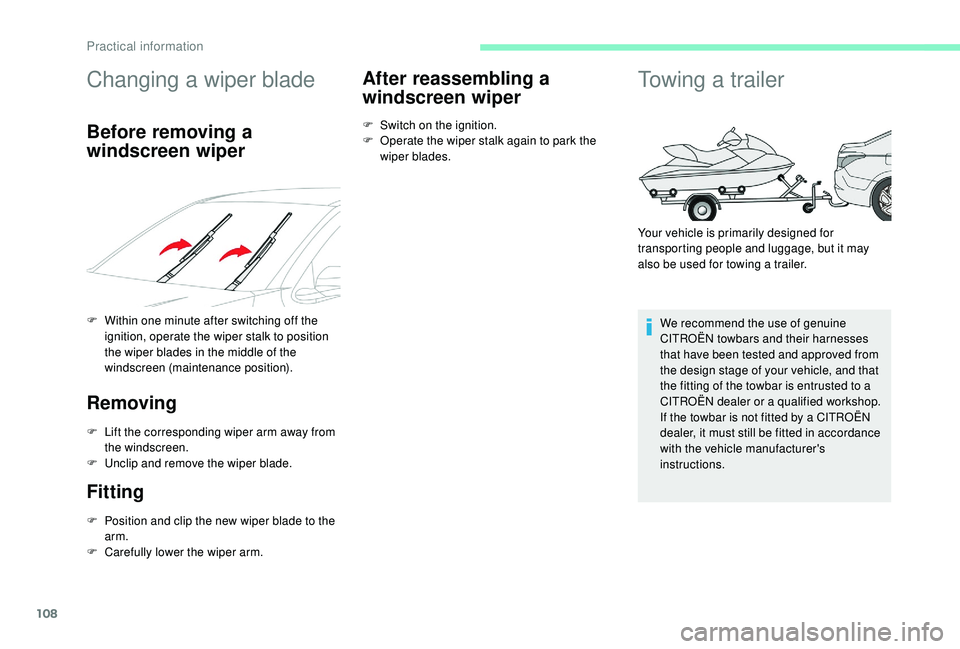
108
Changing a wiper blade
Before removing a
windscreen wiper
F Within one minute after switching off the ignition, operate the wiper stalk to position
the wiper blades in the middle of the
windscreen (maintenance position).
Removing
F Lift the corresponding wiper arm away from the windscreen.
F
U
nclip and remove the wiper blade.
Fitting
F Position and clip the new wiper blade to the arm.
F
C
arefully lower the wiper arm.
After reassembling a
windscreen wiper
F Switch on the ignition.
F O perate the wiper stalk again to park the
wiper blades.
Towing a trailer
Your vehicle is primarily designed for
transporting people and luggage, but it may
also be used for towing a trailer.
We recommend the use of genuine
CITROËN towbars and their harnesses
that have been tested and approved from
the design stage of your vehicle, and that
the fitting of the towbar is entrusted to a
CITROËN dealer or a qualified workshop.
If the towbar is not fitted by a CITROËN
dealer, it must still be fitted in accordance
with the vehicle manufacturer's
instructions.
Practical information
Page 111 of 260

109
Driving with a trailer places greater
demands on the towing vehicle and the
driver must take particular care.
For more information on Driving
recommendations, particularly when
towing, refer to the corresponding section.
Please observe the maximum authorised
towed weights, indicated on the
registration certificate or in your vehicle’s
technical data.
For more information on Weights (and the
towed loads which apply to your vehicle)
refer to the corresponding section.
Obser ve the legislation in force in the
country in which you are driving.Very cold climate
screen(s)
(Depending on the country of sale.)
Removable screen(s) which prevent snow
accumulating at the radiator cooling fan.
Depending on the version, you have one or two
screens.
Before fitting or removing a screen,
ensure that the engine is off and the
cooling fan has stopped.
Fitting
F Place the very cold climate screen in front of the front bumper.
F
P
ress around its edge to engage its fixing
clips one by one.
Removing
F Use a screwdriver as a lever to release each of the fixings of each screen in turn.
It is essential to remove the very cold
climate screen (or screens) in case of:
-
w
hen the exterior temperature exceeds
10°C,
-
w
hen towing,
-
a
t speeds above 75 mph (120 km/h).
Advice on care and
maintenance
Recommendations on the care and
maintenance of your vehicle are given in the
Maintenance and Warranty Guide.
7
Practical information
Page 118 of 260
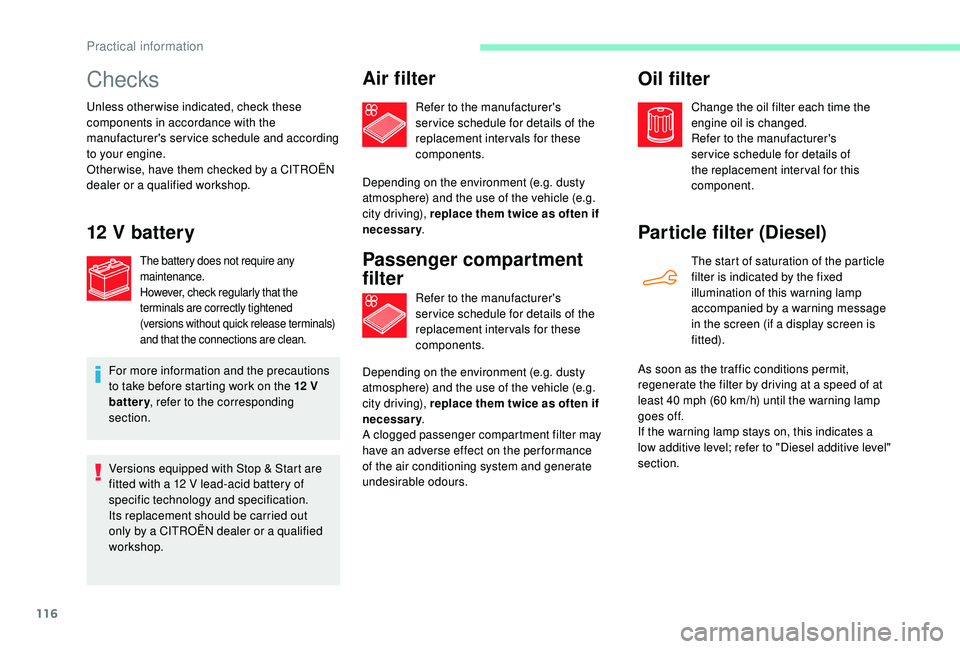
116
Checks
Unless otherwise indicated, check these
components in accordance with the
manufacturer's service schedule and according
to your engine.
Other wise, have them checked by a CITROËN
dealer or a qualified workshop.
12 V battery
The battery does not require any
maintenance.
However, check regularly that the
terminals are correctly tightened
(versions without quick release terminals)
and that the connections are clean.
For more information and the precautions
to take before starting work on the 12 V
battery , refer to the corresponding
section.
Versions equipped with Stop & Start are
fitted with a 12
V lead-acid battery of
specific technology and specification.
Its replacement should be carried out
only by a CITROËN dealer or a qualified
workshop.
Air filter
Refer to the manufacturer's
ser vice schedule for details of the
replacement intervals for these
components.
Depending on the environment (e.g. dusty
atmosphere) and the use of the vehicle (e.g.
city driving), replace them twice as often if
necessary .
Passenger compartment
filter
Refer to the manufacturer's
ser vice schedule for details of the
replacement intervals for these
components.
Depending on the environment (e.g. dusty
atmosphere) and the use of the vehicle (e.g.
city driving), replace them twice as often if
necessary .
A clogged passenger compartment filter may
have an adverse effect on the per formance
of the air conditioning system and generate
undesirable odours.
Oil filter
Change the oil filter each time the
engine oil is changed.
Refer to the manufacturer's
ser vice schedule for details of
the replacement inter val for this
component.
Particle filter (Diesel)
The start of saturation of the particle
filter is indicated by the fixed
illumination of this warning lamp
accompanied by a warning message
in the screen (if a display screen is
fitted).
As soon as the traffic conditions permit,
regenerate the filter by driving at a speed of at
least 40
mph (60 km/h) until the warning lamp
goes off.
If the warning lamp stays on, this indicates a
low additive level; refer to "Diesel additive level"
section.
Practical information
Page 119 of 260

117
On a new vehicle, the first particle
filter regeneration operations may be
accompanied by a "burning" smell, which
is per fectly normal.
Following prolonged operation of the
vehicle at very low speed or at idle,
you may, in exceptional circumstances,
notice the emission of water vapour at the
exhaust on acceleration. This does not
affect the behaviour of the vehicle or the
environment.
Manual gearbox
The gearbox does not require any
maintenance (no oil change).
Automatic gearbox
The gearbox does not require any
maintenance (no oil change).
Brake pads
Brake wear depends on the style
of driving, particularly in the case
of vehicles used in town, over short
distances. It may be necessary to
have the condition of the brakes
checked, even between vehicle
services.
Unless there is a leak in the circuit, a drop in
the brake fluid level indicates that the brake
pads are worn.
Brake disc wear
For information on checking brake
disc wear, contact a CITROËN
dealer or a qualified workshop.
Parking brake
If excessive travel or a loss of
effectiveness of this system is
noticed, the parking brake must
be checked, even between two
services.
This system must be checked by a CITROËN
dealer or a qualified workshop. Only use products recommended by
CITROËN or products of equivalent quality
and specification.
In order to optimise the operation of units
as important as those in the braking
system, CITROËN selects and offers very
specific products.
After washing the vehicle, dampness, or
in wintry conditions, ice can form on the
brake discs and pads: braking efficiency
may be reduced. Make light brake
applications to dry and defrost the brakes.
7
Practical information